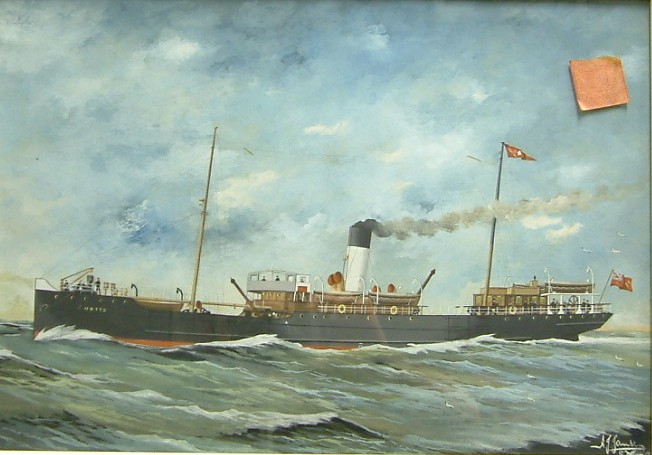So far in these blogs I have looked at what could be called the more glamorous jobs performed by ships requisitioned from the Railway Fleet, but the rapidly expanding Royal Navy also needed ships to perform the day to day routine and maintenance required by the Fleet. The Lancashire and Yorkshire Railway and the Great Central Railway found that many of the foreign ports they served had fallen into the sphere of influence of the Central Powers and therefore it was impossible to continue their services, it is therefore unsurprising that their ships became available for use.
The vital need to supply war ships meant that the need for stores vessels increased and this is primarily where the cross channel steamers of the GCR and the L&Y were used. They transported ammunition, explosives, food, coal and all manner of naval spares and operated in all European naval theatres of war. The GCR provided at least seven vessels and four came from the L&Y.
1977-5781 Great Central Railway steamer SS Notts, by Alfred J Jansen. Copyright NRM/SSPL
The Great Central also provided three paddle steamers; Brocklesby and Cleethorpes were assigned to the Auxiliary Patrol Service. Used to combat submarines these vessels were armed with deck guns and by late 1917 7.5 inch Naval Howitzers, or anti submarine mortars. The other paddle steamer Killingholme became a fleet messenger.
1975-7945 Paddle box cover possibly from PSS Killingholme: Copyright NRM/SSPL
Smaller vessels were not exempt from requisition either, all five GWR tenders based at Plymouth were taken over at the outset of the war. Their original purpose, the transfer of passengers and their belongings between the shore and the large passenger ships, was adapted to their new circumstances – ferrying soldiers and sailors from shore to waiting troopships and warships. Of the five Atalanta was adapted for salvage and rescue work, whilst Smeaton found herself operating with the US Navy in France. The GER paddle steamer Suffolk undertook similar work as did the Midland Railway tug Wyvern. The GER were also to contribute the Harwich – Felixtowe launches Pinmill, Hainault & Epping to harbour work duties.
DY 1288 SS Wyvern, Midland Railway: Copyright NRM/SSPL
At least twelve vessels from across the railway fleet were also requisitioned for duties as troopships, some operating in the very unfamiliar waters of the Mediterranean.
1975-7916 Model ship, Twin-Screw Steamship `Maid of Orleans’. Copyright NRM/SSPL
“Maid of Orleans” was requisitioned from the South Eastern and Chatham Railway as soon as she was completed by Wm Denny & Bros and went straight into service as a troopship in 1918.
Perhaps the most peculiar service rendered by a railway ship was that of the GCR Steamship Accrington which served as a Prisoner of War Accommodation Ship (so far as I can find out the only railway ship to be used as such) until 1917 when she was converted into an Accommodation Ship for a Naval Training Establishment.
Finally it should also be noted that the harbour support vessels such as dredgers, lighters and tugs continued to work under their owner’s flags regardless of whether the port had been taken over or whether they were servicing Merchant or Royal Navy vessels.



